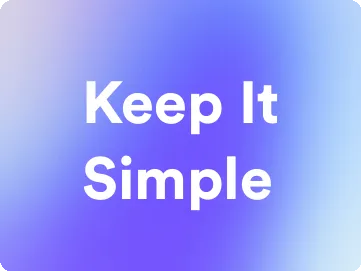Keep It Simple: The Art of Productivity and Efficiency
This guide will walk you through the essential elements of using keep it simple - the productivity method to keep your team productive and engaged.
Try Lark for Free
In today's fast-paced world, the concept of "keep it simple" has become an indispensable mantra for achieving productivity and efficiency, not only in professional endeavors but also in personal life. The ideology behind keeping it simple is to eliminate unnecessary complexities and streamline processes to focus on what truly matters, thereby enhancing performance and reducing stress. In this comprehensive guide, we will delve into the origins of "keep it simple," its applicability, advantages and disadvantages, actionable tips, a step-by-step guide, and essential do’s and don’ts to master the art of simplicity.
What is "Keep It Simple" in the Context of Productivity?
At its core, "keep it simple" signifies a mindset and approach that advocates for the minimization of unnecessary complexities, distractions, and redundancies in all aspects of life. In the context of productivity, keeping it simple entails prioritizing tasks, decluttering workflows, and fostering a clear and focused work environment. By doing so, individuals can dedicate their time and energy to essential tasks, leading to heightened productivity and a sense of accomplishment.
This principle can be applied in various spheres, such as project management, time management, decision-making, and even in the design of products and systems. Embracing simplicity allows individuals to avoid overcomplicating processes, thereby enhancing efficiency and effectiveness.
The Origin of "Keep It Simple"
The concept of keeping it simple can be traced back to the 14th-century philosopher, William of Ockham, and his renowned problem-solving principle, Occam's Razor. This principle, often paraphrased as "the simplest solution is most likely the right one," underscores the significance of simplicity in resolving complex issues. Moreover, the popularization of the phrase "keep it simple" is often attributed to the world of design and engineering, where the pursuit of simplicity is valued for its ability to enhance usability and functionality.
In modern times, the tech industry has notably adopted the "keep it simple" ethos through user experience design and software development, recognizing that streamlined and intuitive solutions are pivotal for user satisfaction and engagement.
Use Lark to unleash your team productivity.
Who is "Keep It Simple" For?
The "keep it simple" approach is pertinent for individuals across various professions and lifestyles, from corporate executives and entrepreneurs to artists and educators. Professionals seeking to boost their productivity and effectiveness can benefit significantly from integrating simplicity into their work ethos. Likewise, students, creatives, and homemakers can harness the power of simplicity to reduce stress, improve time management, and elevate their overall well-being.
Pros and Cons of "Keep It Simple"
Pros:
-
Enhanced Productivity: Simplifying processes and workflows can lead to increased productivity and efficiency, allowing individuals to achieve more in less time.
-
Reduced Stress: By eliminating unnecessary complexities, individuals can experience reduced stress levels, promoting a sense of calm and clarity.
-
Improved Focus: Embracing simplicity enables individuals to focus on essential tasks, thus enhancing concentration and effectiveness.
Cons:
-
Risk of Oversimplification: In certain scenarios, oversimplifying tasks or projects may lead to overlooking critical details and potential complexities, resulting in subpar outcomes.
-
Resistance to Change: Implementing a "keep it simple" approach may encounter resistance from individuals accustomed to more intricate or traditional processes.
Learn more about Lark x Productivity
How to Get Started with "Keep It Simple"?
Getting started with "keep it simple" involves a combination of mindset shifts and practical strategies to streamline workflows and enhance efficiency. Here are actionable steps to begin integrating simplicity into your daily routine:
Prioritize Your Tasks
- Create a list of your daily, weekly, or monthly tasks.
- Prioritize these tasks based on their importance and urgency.
- Allocate specific time slots for each task, ensuring a balanced workload.
Declutter Your Workspace
- Identify and eliminate unnecessary items from your workspace.
- Organize essential tools and materials in a systematic manner to reduce visual clutter.
- Optimize ergonomics to create a more comfortable and functional work environment.
Streamline Digital Workflows
- Utilize productivity tools that simplify task management and communication.
- Organize digital files and folders in a logical structure for easy access.
- Minimize multitasking and focus on one task at a time to enhance concentration.
Use Lark to unleash your team productivity.
Actionable Tips for "Keep It Simple"
Do's
| Do's |
|---|
| Embrace minimalism in your work and living spaces. |
| Prioritize essential tasks to avoid getting overwhelmed. |
| Communicate and collaborate effectively to streamline processes. |
Dont's
| Dont's |
|---|
| Overcomplicate tasks for the sake of perceived thoroughness. |
| Succumb to the allure of unnecessary features or functionalities. |
| Disregard feedback and insights from stakeholders in favor of streamlined processes. |
